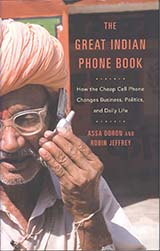-
The Great Indian Phone Book by Assa Doron and Robin Jeffery is motivated by an understanding of the drastic change from the 1960s, the era of rare telephone sets and complete governmental control of the services, to the emergence of Public call office (PCOs) in the 1990s, and to the induction of the mobile phone in first decade of the twenty-first century in India. In the process the authors discover the special impact such a revolution has on a large country with a huge population that is also so diverse. The authors provide a perspective about what goes on behind the scenes to produce mobile phones and services.
-
No doubt mobile phones are the most revolutionary technological innovation of recent times that have affected people, their culture, relations, business, governments, social mobility and politics. Although we are affected by the presence of mobile phones in subtle ways, we have not been able to understand this revolution in a holistic manner. The Great Indian Phone Book aims to fill this gap.
-
The arrival of mobile phones, the different ways they have affected people's lives and how small industry developed around this small instrument are superbly dealt with by the authors of this book. The book focuses on India, though it gives comparative effects of the arrival of the mobile phone in other countries as well. In particular the authors provide an interesting insight to communication taking control of the state and/or social. At the same time, the book does not overlook the flip side of its use, that is, using technology for crimes such as terrorist activities, pornography etc.
-
The eight chapters of the book are placed in three sections:
-
Controlling—there are two chapters that deal with a historical perspective of how the politically powerful have had a monopolising control on information; as well as outlining the technicality involved in the move to the radio frequency spectrum and the involvement of big business and politicians.
-
Connecting—this section deals with the power of connectivity with the mobile phone in a very interesting way. It deals with how just within a decade mobile phones and supporting technology reached the length and breadth of the country with a population so varied in means, social status and capacity.
-
Consuming—this is the most interesting and largest section of the book. The section describes the diversity of consumers using the mobile phone and to what end. It also discusses how a side industry of cheap phones has developed. This part, on the one hand, shows the revolution the use of mobile phone brought, not only for individuals, but in the very way of public communication and, on the other, how cameras in the mobile phone have been also used to commit crimes. The mobile phone has become such a necessity that one in every two Indians started losing mobile phones. Criminals have become smarter in stealing and sending sex-related MMS and the law could hardly match these moves and has been slow in catching up with them.
Each chapter is a theme in itself. The authors rightly claim that each chapter can be developed into a book.
-
The book is well researched and keeps clear of passing value judgments or confronting Hindu sensibilities. The authors give sufficient importance to the technology, business and politics involved. The book's lucid writing style is packed with information from different aspects of the mobile phone induction in India, making The Great Indian Phone Book a very engaging read. The book has 38 revealing illustrations to substantiate the claims. In addition, the authors' long association with India provides them with the requisite insights in to Indian history and culture. Yet being foreigners to India, they are able to point out the obvious.
-
The book gives a detailed description of 'process' and 'activity' that mobile phones generate—power of information, technicality involved, making of cheap mobile phones, the revolution in ways of communicating, new crimes etc. The book deals with the complexity and vastness of India and the ever-growing cheaper networks and phones that have led to a dynamic chapter in Indian history. The authors discuss the impact of mobile phones on health: improved accessibility to health services; mobile waste: the extraction of rare earth elements, as well as India and the less privileged countries becoming the dumping grounds of e-waste. The book examines social networks of a country with 11 different scripts and 28 officially recognised languages and hierarchies of many sorts which move 'idiosyncratically' in using this autonomy offered by mobiles. Music and games on mobile phones has opened unimagined possibilities. With regard to language and media, the mobile communication has an edge over linguistic rules and formal ways of expression, with providers having to recognise the potential of new ways of communication over print media. A focus on politics and governance highlights how communication between the powerful and the common person was unthinkable until the arrival of the mobile phone. The book has something for everyone. A well informed reader will gain a holistic picture of the mobile phone revolution in India.
-
The book is a journalistic account of an important chapter of Indian history. Those who are looking for deeper analysis of any of the impacts of the induction of the mobile phone in India would get some direction for further research. The book successfully gives a meta-picture of the revolution.
|

